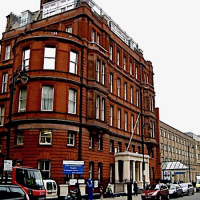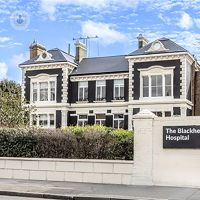What is a macular hole?
A macular hole is a traction hole in the macula, which is the centre of the retina. The macular area of the retina is responsible for providing the high resolution required for everyday activities such as reading.
There are two types of macular hole: lamellar macular holes do not affect the entire thickness of the retina, while full-thickness macular holes do. There are also different stages of macular hole:
- Stage 1: detachment of the fovea (the area of the retina in the centre of the macula)
- Stage 2: full-thickness hole in the fovea
- Stage 3: the hole grows bigger
- Stage 4: the macular hole is associated with posterior vitreous detachment

What is the prognosis?
The outlook is very good. It is very rare for holes to resolve spontaneously, but modern surgical techniques allow more than 90 per cent of cases to be treated successfully.
What are the symptoms of a macular hole?
The main symptoms of a macular hole are loss of central vision and distorted vision in one eye. The distortion causes straight lines to become wavy, such that numbers and letters seem to jump out or distort. Other symptoms include a central grey area, or a blind area in the central vision. In the early stages of the disease, a yellowish lesion can be detected in the fovea.
How is a macular hole diagnosed?
To diagnose a macular hole, the back of the eyes are examined. The specialist dilates the pupils before examining the retina. Optical coherence tomography (OCT) is an examination used to determine the size of the hole, allowing the specialist to determine the prognosis and also to confirm closure of the hole post-operatively.
What causes a macular hole?
Most cases of macular hole are idiopathic, i.e. the macular hole develops in healthy patients without any evidence of other eye diseases. Macular holes are more likely to occur as you get older.
A macular hole may also develop as a result of:
- myopia
- traumatic eye injury
- chronic inflammation of the macula
- intraocular surgery
Can it be prevented?
Macular holes cannot be prevented, although they can be detected in the early stages. The sooner the hole is detected, the better the visual recovery is.
How are macular holes treated?
Macular holes are treated by vitrectomy (removing the innermost retinal layer) followed by the insertion of intraocular gas. In many patients, vitrectomy surgery is combined with cataract surgery to avoid the need for a second procedure.
Patients should assume the gas bubble will block vision for up to one month post operatively before clearing and allowing better vision. Depending on the size of the hole, many surgeons will ask their patients to help close the hole by posturing face down post-operatively for a few days.
Which specialist treats it?
Macular holes are treated by some ophthalmologists who specialise in vitreo-retinal surgery.
01-25-2013 06-07-2023Macular hole
Mr Vaughan Tanner - Ophthalmology
Created on: 01-25-2013
Updated on: 06-07-2023
Edited by: Conor Lynch
What is a macular hole?
A macular hole is a traction hole in the macula, which is the centre of the retina. The macular area of the retina is responsible for providing the high resolution required for everyday activities such as reading.
There are two types of macular hole: lamellar macular holes do not affect the entire thickness of the retina, while full-thickness macular holes do. There are also different stages of macular hole:
- Stage 1: detachment of the fovea (the area of the retina in the centre of the macula)
- Stage 2: full-thickness hole in the fovea
- Stage 3: the hole grows bigger
- Stage 4: the macular hole is associated with posterior vitreous detachment

What is the prognosis?
The outlook is very good. It is very rare for holes to resolve spontaneously, but modern surgical techniques allow more than 90 per cent of cases to be treated successfully.
What are the symptoms of a macular hole?
The main symptoms of a macular hole are loss of central vision and distorted vision in one eye. The distortion causes straight lines to become wavy, such that numbers and letters seem to jump out or distort. Other symptoms include a central grey area, or a blind area in the central vision. In the early stages of the disease, a yellowish lesion can be detected in the fovea.
How is a macular hole diagnosed?
To diagnose a macular hole, the back of the eyes are examined. The specialist dilates the pupils before examining the retina. Optical coherence tomography (OCT) is an examination used to determine the size of the hole, allowing the specialist to determine the prognosis and also to confirm closure of the hole post-operatively.
What causes a macular hole?
Most cases of macular hole are idiopathic, i.e. the macular hole develops in healthy patients without any evidence of other eye diseases. Macular holes are more likely to occur as you get older.
A macular hole may also develop as a result of:
- myopia
- traumatic eye injury
- chronic inflammation of the macula
- intraocular surgery
Can it be prevented?
Macular holes cannot be prevented, although they can be detected in the early stages. The sooner the hole is detected, the better the visual recovery is.
How are macular holes treated?
Macular holes are treated by vitrectomy (removing the innermost retinal layer) followed by the insertion of intraocular gas. In many patients, vitrectomy surgery is combined with cataract surgery to avoid the need for a second procedure.
Patients should assume the gas bubble will block vision for up to one month post operatively before clearing and allowing better vision. Depending on the size of the hole, many surgeons will ask their patients to help close the hole by posturing face down post-operatively for a few days.
Which specialist treats it?
Macular holes are treated by some ophthalmologists who specialise in vitreo-retinal surgery.
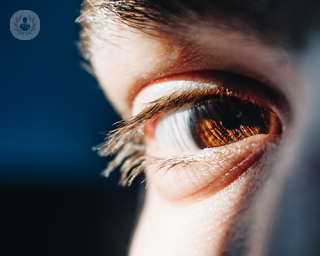

Your guide to full-thickness macular holes and surgery
By Mr Alistair Laidlaw
2024-11-20
When a gap forms all the way through the retina, it's referred to as a full-thickness macular hole. This can cause vision to become darker and blurry but fortunately, there is surgical treatment available to close a macular hole and therefore prevent further deterioration of vision. Mr Alistair Laidlaw provides a comprehensive guide that clarifies symptoms, treatment, the success rate of treatment and more. See more
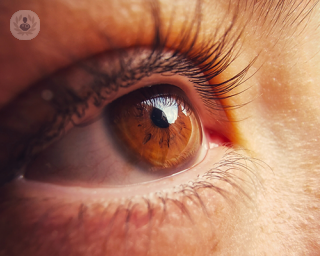

Comprehensive guide to full-thickness macular hole surgery and care
By Professor James Bainbridge
2024-11-20
Macular holes can lead to distorted vision and blind spots. If you have or think you may have a macular hole, surgery provides a promising chance of repairing it and preserving your eyesight. Professor James Bainbridge provides you with an in-depth understanding of macular hole surgery and aftercare. See more


An introduction to macular holes
By Mr Bhaskar Gupta
2024-11-20
In his latest online article Mr Bhaskar Gupta gives us his insights into the macular hole. He explains what it is, why it happens and the treatment. See more
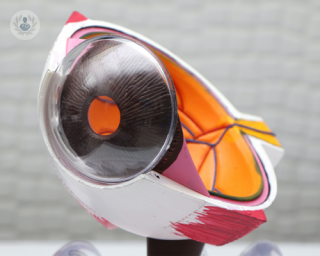

What are macular holes?
By Mr Abdallah Ellabban
2024-11-20
Our vision deteriorates as we get older, one potential cause could be macular holes. But what are macular holes and how do they affect vision? Esteemed consultant ophthalmologist Mr Abdallah Ellabban shares his expertise on the condition. The consultant, who treats patients in East Riding of Yorkshire and Hull, discusses the role of the Amsler grid in monitoring changes in the vision. See more
Experts in Macular hole
-
Mr Mahi Muqit
OphthalmologyExpert in:
- Eye floaters
- Epiretinal membrane
- Diabetic retinopathy
- Vitrectomy
- Macular hole
- Retinal detachment
-
Professor James Bainbridge
OphthalmologyExpert in:
- Cataracts
- Epiretinal membrane
- Macular hole
- Retinal detachment
- Eye floaters
- Retinal detachment surgery
-
Professor Tom Williamson
OphthalmologyExpert in:
- Retinal detachment
- Macular hole
- Epiretinal membrane
- Diabetic retinopathy
- Cataracts
- Vitrectomy
-
Mr Hadi Zambarakji
OphthalmologyExpert in:
- Retinal detachment
- Macular hole
- Epiretinal membrane
- Macular degeneration (AMD)
- Diabetic retinopathy
- Cataracts
-
Mr Roger Wong
OphthalmologyExpert in:
- Retina
- Diabetic retinopathy
- Retinal detachment
- Macular hole
- Epiretinal membrane
- Macular degeneration (AMD)
- See all

Great Ormond Street Hospital
Great Ormond Street Hospital
Great Ormond Street. WC1N 3JH
No existe teléfono en el centro.
By using the telephone number provided by TOP DOCTORS, you automatically agree to let us use your phone number for statistical and commercial purposes. For further information, read our Privacy Policy
Top Doctors

The Blackheath Hospital - part of Circle Health Group
The Blackheath Hospital - part of Circle Health Group
40-42 Lee Terrace, Blackheath, London SE3 9UD
No existe teléfono en el centro.
By using the telephone number provided by TOP DOCTORS, you automatically agree to let us use your phone number for statistical and commercial purposes. For further information, read our Privacy Policy
Top Doctors

The Ridgeway Hospital - part of Circle Health Group
The Ridgeway Hospital - part of Circle Health Group
Moormead Rd, Wroughton, Swindon SN4 9DD
No existe teléfono en el centro.
By using the telephone number provided by TOP DOCTORS, you automatically agree to let us use your phone number for statistical and commercial purposes. For further information, read our Privacy Policy
Top Doctors
-
Great Ormond Street Hospital
Great Ormond Street. WC1N 3JH, Central LondonExpert in:
- Cancer
- Paediatric neurosurgery
- Paediatrics
-
The Blackheath Hospital - part of Circle Health Group
40-42 Lee Terrace, Blackheath, London SE3 9UD, East LondonExpert in:
- Vascular Surgery
- Cardiology
- Bariatric Surgery
- Colorectal surgery
- Endocrine Surgery
- General Surgery
-
The Ridgeway Hospital - part of Circle Health Group
Moormead Rd, Wroughton, Swindon SN4 9DD, SwindonExpert in:
- Breast Cancer
- General Surgery
- Orthopaedic surgery
- Plastic surgery, reconstructive and aesthetics
- Refractive surgery
- Cancer screening clinic
- See all
- Most viewed diseases, medical tests, and treatments
- Genetic testing
- Minimal access surgery (keyhole surgery)
- Botulinum toxin (Botox™)
- Medicolegal
- Dermal fillers
- Headache
- Strabismus (squint)
- Glaucoma
- Diplopia (double vision)
- Amblyopia






